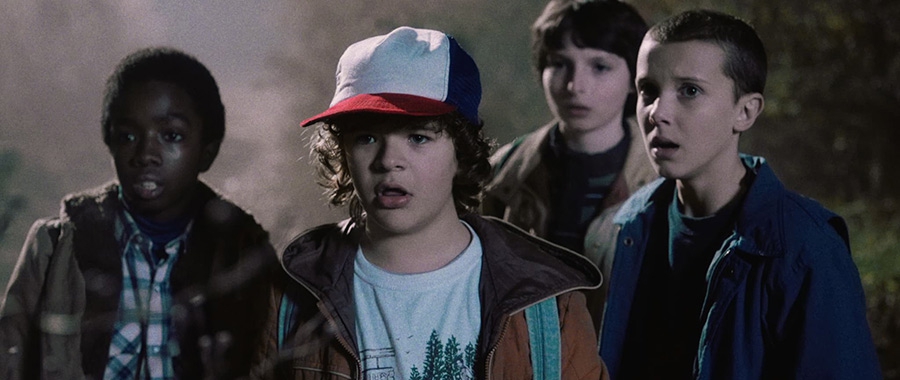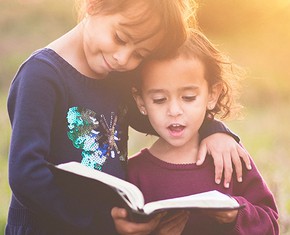The views expressed in our content reflect individual perspectives and do not represent the authoritative views of the Baha'i Faith.
My family has recently become addicted to the sci-fi horror TV series “Stranger Things.”
People kept telling us to watch it and we finally caved and gave it a try. From then on, we were hooked!
The show epitomizes the symbols of good and evil. It revolves around a tough but loveable police chief, a quirky but relatable single mother, and a group of awkward yet endearing teens reminiscent of the Goonies. Then of course there are the chilling, murderous monsters they call the Demogorgons who obey the malicious Mind Flayer and make up a part of his hive mind. The show takes place in a 1980s fictional small town known as Hawkins, Indiana where everyone knows their neighbor and it’s safe to go out alone at night. The town and the lives of its inhabitants are the epitome of pure simplicity and security. Then there’s the “Upside Down.” This world is the very opposite of the one above, in every way—a perfect mirror image, below, that projects the reverse of its counterpart above. Its creatures, values, and physical terrain are diametrically opposed to the world that exists above. Symbolizing good vs. evil, these two worlds exist simultaneously.
The show fascinates us because it represents the age-old struggle of good against evil.
It has been prompting me to reflect on the nature of good and evil, and to remember some of the Baha’i teachings on this topic—such as the idea that in the same way that darkness is the absence of light, evil is the absence of goodness:
Evil is nonexistent; it is the absence of good. – Abdu’l-Baha, The Promulgation of Universal Peace, p. 295.
Briefly, intelligible realities such as the praiseworthy attributes and perfections of man are purely good and have a positive existence. Evil is simply their non-existence. So ignorance is the want of knowledge, error is the want of guidance, forgetfulness is the want of remembrance, foolishness is the want of understanding: All these are nothing in themselves and have no positive existence.
As for sensible realities, these are also purely good, and evil is merely their non-existence; that is, blindness is the want of sight, deafness is the want of hearing, poverty is the want of wealth, illness is the want of health, death is the want of life, and weakness is the want of strength. – Abdu’l-Baha, Some Answered Questions, newly revised edition, pp. 410-411.
But then all of this makes me wonder, what about the evil Demogorgons? Perhaps they are symbolic of what some people refer to as Satan. This aspect of the series has caused me to revisit the Baha’i teachings on Satan, which I have found rather interesting. In the Baha’i teachings, Satan represents the lower nature in ourselves—the part of us which falls prey to selfishness, greed, jealousy, anger, fear, hatred and so forth.
This lower nature in man is symbolized as Satan—the evil ego within us, not an evil personality outside. – Abdu’l-Baha, The Promulgation of Universal Peace, p. 287.
The reality underlying this question is that the evil spirit, Satan or whatever is interpreted as evil, refers to the lower nature in man. … It is evident, therefore, that man is in need of divine education and inspiration, that the spirit and bounties of God are essential to his development. … The journey of the soul is necessary. The pathway of life is the road which leads to divine knowledge and attainment. Without training and guidance the soul could never progress beyond the conditions of its lower nature, which is ignorant and defective. – Ibid., p. 294-296.
In the series, a young boy is abducted and we see the cast of characters’ higher and lower natures manifest themselves. A mother risks appearing crazy to do anything to find her lost son Will. Will’s friends—the underdogs of the series—show their courage by standing up to neighborhood bullies and even the menacing Demogorgons. A strange orphan girl mysteriously appears who possesses supernatural powers that she uses to defend and rescue her friends. The town bully, Steve, transforms into a beloved hero when he changes his once-oppressive nature and fights a Demogorgon to save the girl he loves. Now, symbolically free from his past imperfection, he stops focusing on himself and becomes enlightened.
These episodes have called to my mind the following passages from the Baha’i writings:
Through education we must free ourselves from these imperfections. The Prophets of God have been sent, the Holy Books have been written, so that man may be made free. – Abdu’l-Baha, Paris Talks, pp. 177-178
Man has the power both to do good and to do evil; if his power for good predominates and his inclinations to do wrong are conquered, then man in truth may be called a saint. – Ibid., p. 60.
With all these principles and teachings that Stranger Things calls to mind, it seems the series is a microcosm of our lives.
If so, who are you in its cast of characters? Who do you aspire to be?
Are you the courageous mother who boldly sacrifices for those she loves? A power-hungry Demogorgon that has only selfish and egocentric concerns? The loyal friend who risks harassment to stand up for justice? The reformed bully who evolves to become the champion of the marginalized and oppressed? The kind-hearted hero who rises above fear to fight courageously for the truth? Or the young heroine, an angel on earth whose pure heart is a symbol of all that is good?
Will we choose to embody the negative qualities of greed, bigotry and divisiveness, or will we choose to be heroes here on earth, standing up for equality, working for justice, and exemplifying unity? We can focus on our lower nature, symbolized by the wicked Demogorgon, and seek only material and selfish concerns, or we can turn toward God, and spiritual aspirations, and become a reflection of all that is noble and virtuous in this world. To choose good over evil sounds simple—but then again, I’ve seen Stranger Things.
















Comments
Sign in or create an account
Continue with Googleor